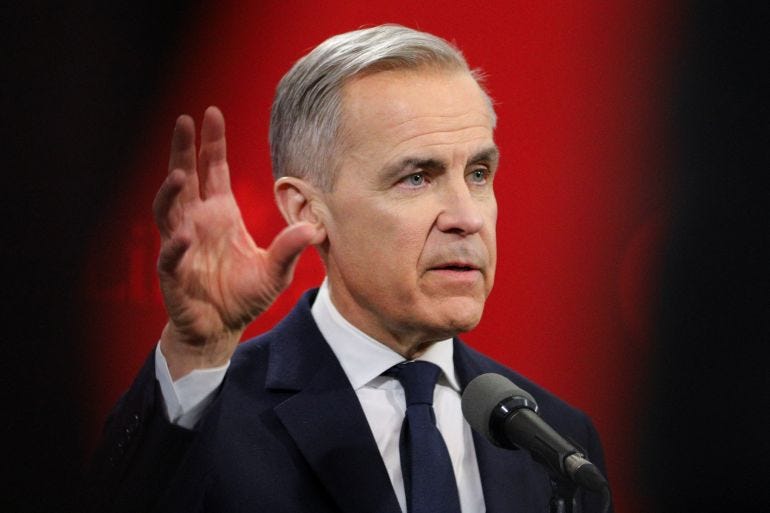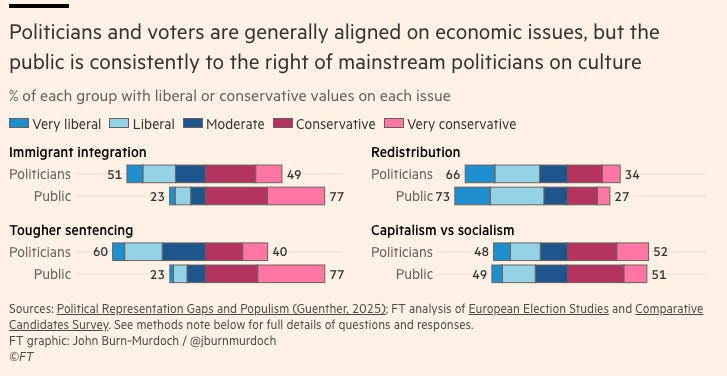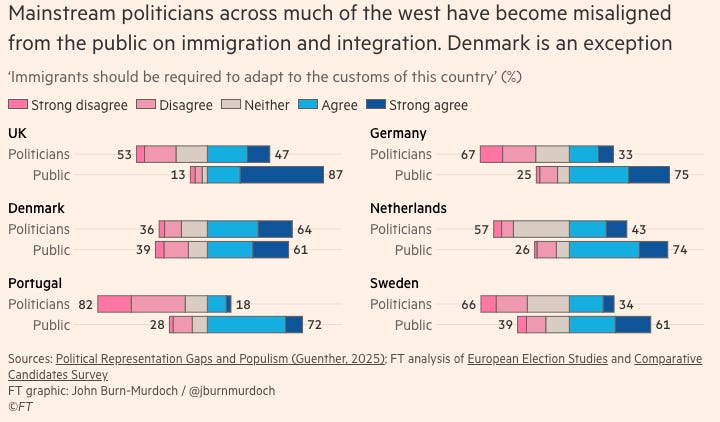Lessons in Ruthless Pragmatism
Democrats Need to Practice Politics Like Canadians, Australians, and Danes
Around the world, a few center-left parties have figured out how to win and stay in power. They do this by ruthlessly prioritizing electoral success over internal comfort. The contrast with American progressive practice is clear and instructive.
Canada: Ruthlessness Over Sentiment
The Liberal party of Canada offers a clear lesson in what it means for a political party to prioritize winning. They responded to problems similar to those confronting Democrats in 2024 with a level of ruthlessness that few American progressives seem capable of mustering.
Justin Trudeau faced no concerns about his age or cognitive ability. The charismatic scion of a storied Prime Minister, he was nonetheless losing badly in the polls. Liberal party leaders did not believe that family legacy or incumbency conferred any privilege. Their logic was brutally simple: the job of a political leader is to win elections, so a leader who is likely to lose is no longer the right person for the job. They forced him out.
What happened next was even more revealing. Chrystia Freeland had established strong progressive credentials within the Liberal party. She had earned her chance to become Canada’s second female Prime Minister. However, having served as a high-profile member of Trudeau’s unpopular cabinet, she was politically tainted. So the party pushed her aside in favor of Mark Carney, the former president of both the Bank of Canada and the Bank of England. Liberals knew that it was a “bad look” to promote a man, much less an international banking technocrat who had never held elected office, over a woman with more experience. But they felt that Carney gave them their best chance of winning — and he won.
Meanwhile, Carney, who had spent years supporting carbon pricing, quickly changed his stance and attacked Trudeau’s consumer carbon tax. Why? The tax was unpopular with voters eager for relief from rising costs. At every decision point, Carney and the Liberals picked the option that would help them win the election.
The results are clear. In six months, Carney has passed the One Canadian Economy Act, which aims to eliminate federal barriers to internal Canadian trade. He has helped speed up major infrastructure projects during a trade war with the United States. He also launched the Build Canada Homes agency. A Conservative government would likely not have pursued these initiatives.
Unlike Keir Starmer in the UK, Carney is maintaining high personal approval ratings. The Liberals continue to lead in the polls. They made tough decisions, faced criticism from their own side, and positioned themselves to win. In fact, criticism from their own side helped Liberals attract new voters and secure the victory.
Australia: Discipline and Focus
Australian Labor offers another model worth studying. They won power in 2022, got re-elected in 2025, and continue to lead in the polls. Their success is similar to Denmark’s and Canada’s: they are ruthlessly pragmatic in addressing cultural flashpoints and maintain a disciplined focus on the kitchen-table economics of working families.
About 30 percent of Australians are foreign-born, which is twice the proportion in the US. The issue of irregular immigration and asylum claims is highly controversial. Nevertheless, Australia enforces strict criteria for “irregular arrivals” (illegal migrants or people who overstay visas) and asylum seekers. Human rights groups are very critical of these practices and standards. Labor ignores them and focuses on voter preferences. Australian voters prefer not to accept large numbers of asylum-seekers, and Labor is unwilling to lose elections by pretending otherwise.
The Australian Labor Party has done what most Democrats claim to want to do. They’ve focused solidly on populist, kitchen-table issues. They raised the minimum wage, invested in community health centers and subsidized health insurance, funded green manufacturing, increased childcare subsidies, and invested in vocational education.
These aren’t just campaign slogans—they’re the genuine focus of Labor’s governance. And that requires discipline. It means staying focused and avoiding unnecessary conflicts. Many progressives claim this is literally impossible, that you cannot have a political movement that focuses only on popular issues. Australian Labor proves otherwise.
The leader of the Australian Labor Party, Anthony Albanese, and his colleagues should hold seminars for Democrats. They could present data collected by John Burns-Murdoch showing that liberal political leaders are aligned with the public on key economic issues but are badly out of step on immigration and crime.
Burns-Murdoch’s data also shows that Denmark is doing something different from other European countries.
I wrote about the Danish Social Democrats here.
The High Cost of Losing
Building an electoral coalition strong enough to win elections is the main goal of democratic politics. It requires leaders to separate their personal beliefs from the public positions necessary to win political power. There is no room for those who believe that sticking to unpopular views on issues like immigration and crime will become popular if they just try hard enough.
Progressive leaders used to understand this. Barack Obama publicly opposed gay marriage when he ran for president in 2008. Bill Clinton publicly adopted centrist rhetoric, downplayed certain socially liberal positions, and used strategic ambiguity on controversial issues to broaden his appeal and win the presidency. He deliberately avoided cultural flashpoints such as affirmative action and gay rights, and divisive social policies during his 1992 campaign, even though Clinton personally supported progressive stances on many of these issues. While Clinton and his closest advisers privately favored more activist government economic policies, he downplayed these views publicly to focus on the recession and the slogan “The Economy, Stupid,” thus appearing more in touch with mainstream concerns.
Both Clinton and Obama took office with Democrats controlling both houses of Congress. Recall, however, that when Democrats passed the Affordable Care Act in 2010, some 40 House Democrats identified as pro-life. Obama and his team had to negotiate with Bart Stupak and his anti-abortion group, which was frustrating. However, with Nancy Pelosi's help, they passed the Affordable Care Act.
Today, Democrats do not need to worry about these kinds of negotiations because the Democratic caucus is more ideologically pure. It is, of course, also much less powerful; it cannot pass anything like the ACA.
Or consider Senate math. How does Sherrod Brown win back his Senate seat in Ohio with the Democratic brand badly tarnished by deeply unpopular views on immigration and crime? How do Dems win seats in places like Kansas or Missouri with candidates forced to check every box on the progressive wishlist? Democrats used to run pro-life candidates in certain states. They ran candidates who favored secure borders, deportations, and well-funded police. These are not the most salient issues in some deep-blue states, but they are for many red states that voted blue within recent memory.
Most Democrats now believe that the cost of losing political power throughout government is dangerous in an age of authoritarian populism. Many take heart in the fact that Donald Trump has some of the lowest approval ratings of any US president. They should recognize that one group has approval ratings that are even lower than Trump’s: Congressional Democrats.
Sources: Gallup, Pew, NYT/Siena. Summary of September 2025 data from polls that used different sampling methodologies on different survey dates.
Taking Seriously the Practice of Politics
The threat to Democratic popularity is not Bernie Sanders, AOC, Zohran Mamdani, or other leaders of the party’s left wing. Democrats will always have a left wing, and they deserve to be listened to, especially on issues like labor and donor influence. The biggest threat facing Democrats is their tendency to lose by doubling down on unpopular ideas. Democrats who prioritize purity over pragmatism, losing beautifully over winning with moderated views, or treating an effective electoral strategy as a moral compromise are not actually practicing democratic politics.
Democrats need to do the challenging work of separating personal beliefs from a winning electoral strategy. Leaders must accept that democracy truly requires them to listen to what voters want — especially when that leader deeply wishes they wanted something different.
Progressive parties in Canada and Australia view politics as a democratic practice, rather than a public spectacle. They focus on winning elections, not reassuring activists. They stay focused on voter preferences, even if it means absorbing criticism from interest groups, single-issue donors, or social media algorithms.
Canadian Liberals, Danish Social Democrats, and Australian Labor demonstrate what it means to take winning seriously. At every decision point, these parties pick the path that helps them succeed. They stay focused on issues that matter to voters. They refuse to let perfection be the enemy of victory.
The question is whether Democrats are serious about winning and what they are willing to do to achieve that goal. Because if they are not willing to make tough choices, prioritize winning over comfort, or learn from those who are actually succeeding, they should stop pretending to care about results. They should admit that they prefer the appearance of principled opposition over the messy reality of winning and governing.
If the stakes are as high as Democrats claim, and losing truly is frightening and risky, then they need to approach politics the way successful parties do.




